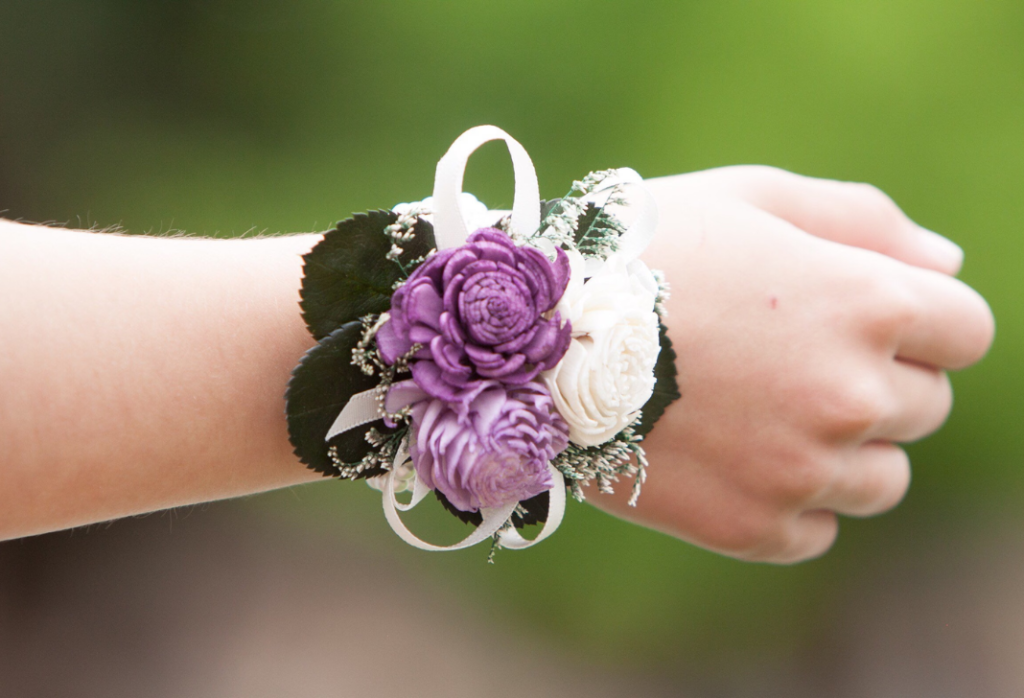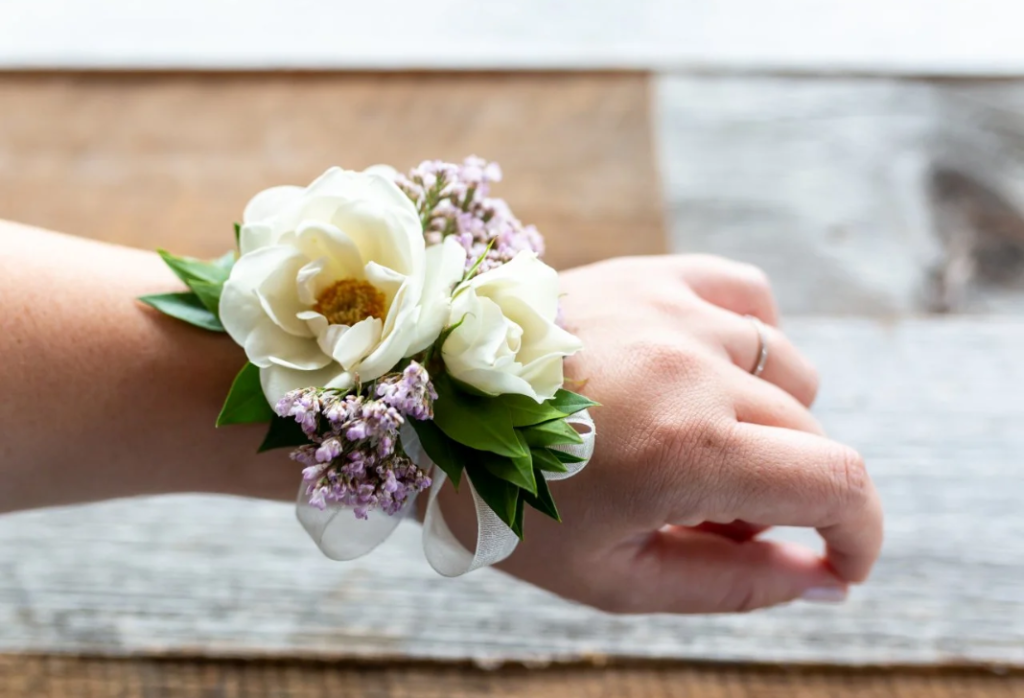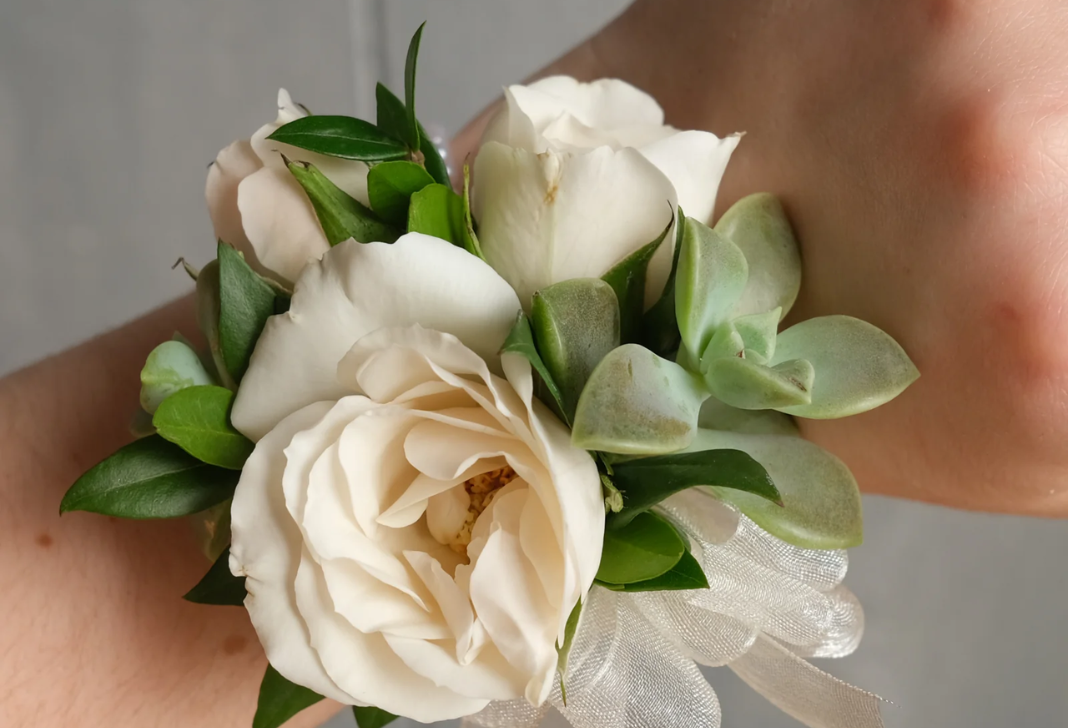The corsage is one of the most charming and elegant accessories you can wear to special events like proms, weddings, or other celebrations. While it may seem like a small detail, a corsage adds a touch of sophistication and beauty that can enhance any outfit. Whether you’re a first-time buyer or someone looking to refresh your knowledge, this guide will provide all the essential information about corsages, from their history and types to tips on how to wear and care for them.
In this article, we’ll explore what a corsage is, the different types of corsages available, when and how to wear them, and the best flowers to use in corsages. Let’s dive in!
What is a Corsage?
A corsage is a small arrangement of flowers that is worn as an accessory, typically pinned to the clothing. Corsages are often worn on the wrist, pinned to a dress, or attached to a suit jacket, and they’re typically given during special occasions such as proms, weddings, anniversaries, or other formal events.
The flowers in a corsage are typically fresh, but they can also be made from silk or other artificial materials. While corsages are traditionally floral, they can also incorporate other elements, such as ribbons, pearls, or even feathers, to enhance their aesthetic.
The History of the Corsage
Corsages have a long and rich history, dating back hundreds of years. In the past, they were commonly known as “bouquet garni” and were worn by both men and women. The practice of wearing floral arrangements began in Ancient Greece, where flowers were used for ceremonial purposes, as symbols of wealth, or to represent a connection with nature.
In the Victorian era, the tradition of wearing corsages really took off. The corsage became an important part of formal attire, and it was during this time that flowers became the key component. In the early 20th century, corsages were particularly popular among young women attending proms or dances, marking a significant fashion trend during these social gatherings.

Types of Corsages
When it comes to choosing the perfect corsage, there are several options available depending on your style, the event, and personal preferences. Let’s take a look at the different types of corsages:
Wrist Corsage
A wrist corsage is one of the most popular types, especially for prom and formal events. The flowers are typically arranged on a small band or bracelet, which is worn around the wrist. This style is convenient, as it doesn’t require pinning and offers a modern, chic look.
When to Wear:
- Prom
- Weddings (bridesmaids or guests)
- Formal parties or galas
Pros:
- Easy to wear and move around in
- Can be made with a variety of flowers and accents
- Comfortable for long hours of wear
Pin-on Corsage
A pin-on corsage is the traditional style. The flowers are arranged and then attached to a pin, which is fastened to your dress or jacket. This style works well for more formal events, and you can attach the corsage to different parts of your outfit (such as on the left side of your chest, near your shoulder, or even on the waistband).
When to Wear:
- Weddings (bridesmaids or guests)
- Proms
- Formal dinner events
Pros:
- A classic, elegant look
- Versatile and can be worn in different placements on the body
Boutineer Corsage
The boutineer corsage is typically worn by men. It’s pinned to the lapel of a suit or tuxedo. While it’s similar to the pin-on corsage, it’s specifically designed for men’s attire. These corsages usually feature more subtle flowers like roses, orchids, or baby’s breath, and are often paired with a ribbon.
When to Wear:
- Weddings (groomsmen or the groom)
- Prom (for the date)
- Other formal occasions
Pros:
- Simple yet elegant
- Complements formal wear without overpowering the look
Hair Corsage
A hair corsage is a floral arrangement that is worn in the hair, typically as a clip or hairband. It’s an elegant way to add flowers to your outfit without covering too much of the fabric. Hair corsages are very popular for weddings, especially for brides and bridesmaids.
When to Wear:
- Weddings
- Proms
- Special occasions like anniversaries or garden parties
Pros:
- Adds a unique touch to hairstyles
- Perfect for those who prefer not to wear flowers on their clothing

Best Flowers for a Corsage
Choosing the right flowers for a corsage is key to creating a beautiful and lasting accessory. Here are some of the most popular flowers used in corsages:
Roses
Roses are a classic choice for corsages. Their timeless beauty and wide range of colors make them ideal for almost any event. Red roses represent love and passion, while white roses symbolize purity and innocence. Pink roses are often used for more romantic events like weddings and anniversaries.
Orchids
Orchids have an exotic appeal and are often used in more sophisticated and formal corsages. Their delicate appearance adds elegance to any outfit, making them ideal for upscale events like galas or formal weddings.
Carnations
Carnations are a popular choice because of their long-lasting nature and availability in many colors. They’re versatile, budget-friendly, and have a soft, romantic vibe. They’re often used for prom corsages or for Mother’s Day events.
Tulips
Tulips represent new beginnings and are often used for spring events like weddings, proms, or garden parties. They’re elegant and can add a fresh, colorful touch to any corsage.
Lilies
Lilies are known for their delicate petals and sweet fragrance. They come in a variety of colors, including white, pink, orange, and yellow, and are often used for more formal or religious occasions, such as weddings or anniversaries.
Baby’s Breath
While a baby’s breath isn’t always the main flower in a corsage, it is frequently used as a filler flower. Its tiny, white blossoms create a soft, airy effect and can complement other larger flowers like roses or orchids.
Freesia
Freesia flowers are known for their sweet fragrance and bright, colorful blooms. They’re a popular option for spring and summer corsages and are commonly used in both wrist corsages and hair corsages.

When to Wear a Corsage
Corsages are perfect for any formal event or celebration where you want to add a little extra touch of elegance. Below are some of the most common occasions where you’ll see corsages:
Weddings
Corsages are often worn by bridesmaids, the bride, and guests at weddings. For the bride, a flower crown or a corsage may be worn to complement the bridal gown. For the groom, a boutonnière (a small flower attached to the lapel) is a popular choice.
Proms and Formals
A wrist corsage is the go-to accessory for prom, offering a beautiful, modern look. A pin-on corsage can also be a great option if you’re looking for something more traditional. It’s common to coordinate the color of the corsage with the dress or tuxedo to create a cohesive look.
Anniversaries
Wearing a corsage for an anniversary, particularly a wedding anniversary, can be a thoughtful way to celebrate love. For example, a couple might exchange corsages as part of the anniversary celebrations.
Graduations
Corsages can also be worn for graduation ceremonies or parties to add a festive, celebratory flair to the occasion.
How to Care for a Corsage
Corsages are delicate and need proper care to stay fresh. Here are some tips to keep your corsage looking beautiful:
- Keep it cool: Corsages should be stored in a cool place, away from direct sunlight or heat.
- Water it: If the corsage is made of fresh flowers, it’s essential to keep the flowers hydrated. Mist the flowers with water if you’re not wearing it right away.
- Avoid heavy perfume: Strong perfumes can damage the flowers, so avoid using them when wearing a corsage.
- Wear it carefully: If you’re wearing a pin-on corsage, make sure it’s securely fastened and doesn’t get caught on anything. Wrist corsages should be worn on the wrist gently to avoid crushing the flowers.
Conclusion
The corsage is a timeless accessory that has remained a favorite for many special occasions, from proms and weddings to anniversaries and formal events. Whether you choose a wrist corsage, pin-on corsage, or even a boutonnière, this floral accessory can add a touch of elegance and sophistication to any outfit.
By understanding the history, types, and best flowers to use, you’ll be well-equipped to select the perfect corsage for your next special event. And with proper care, your corsage will look fresh and beautiful throughout the day, ensuring you feel your best while celebrating life’s milestones.
So, whether you’re preparing for a wedding, prom, or just a night out, remember that a corsage can elevate your look and make the event even more memorable.
FAQs
1. What is a corsage?
A corsage is a small floral arrangement worn as an accessory, typically at special occasions such as weddings, proms, or formal parties. It can be worn on the wrist, pinned to clothing, or in the hair, and is usually made of fresh or artificial flowers.
2. What’s the difference between a corsage and a boutonnière?
A corsage is worn by women, typically on the wrist, chest, or in the hair, while a boutonnière is worn by men, often pinned to the lapel of a suit or tuxedo. The boutonnière usually consists of one or two flowers, while the corsage is a small bouquet or arrangement.
3. When should I wear a corsage?
Corsages are worn for special events like weddings, proms, formal dinners, anniversaries, or graduations. They are typically worn to complement a formal or semi-formal outfit and can be given as a gesture of affection or celebration.
4. What types of corsages are available?
There are several types of corsages, including:
- Wrist Corsages: Worn on the wrist like a bracelet.
- Pin-on Corsages: Pinned to the dress or jacket.
- Hair Corsages: Attached to the hair as a clip or headband.
- Boutonnières: Typically worn by men, pinned to the lapel.
5. What flowers are best for a corsage?
Popular flowers for corsages include:
- Roses (classic and romantic)
- Orchids (elegant and exotic)
- Carnations (long-lasting and versatile)
- Tulips (bright and cheerful)
- Lilies (fragrant and elegant)
- Baby’s Breath (a delicate filler) The choice depends on your event, color preferences, and season.
6. How do I care for a corsage?
To care for a fresh corsage:
- Keep it cool: Store it in a cool place, away from direct sunlight and heat.
- Water it: Lightly mist the flowers with water if you’re not wearing it right away.
- Wear carefully: If pinned, make sure it’s securely fastened. For wrist corsages, avoid squashing the flowers.
- Avoid strong perfume: It can damage the delicate petals.
7. How do I attach a corsage to my outfit?
A pin-on corsage is attached using a small safety pin or corsage pin. You can pin it to your dress, jacket, or other part of your outfit. A wrist corsage comes on an elastic band or small bracelet, which can be slipped on like jewelry. Hair corsages are typically clipped into the hair using bobby pins or a small clip.
8. Can I wear a corsage with a casual outfit?
Corsages are typically worn with formal or semi-formal attire. However, you could wear a more relaxed, smaller corsage with a less formal dress or outfit for certain occasions, like a garden party or family event. It’s important to balance the style of the corsage with the formality of the event.
9. Can I make my own corsage?
Yes, you can make your own corsage! DIY corsages can be a fun and creative project. You’ll need flowers, a corsage pin or wristband, floral tape, and additional elements like ribbon or decorative beads. There are plenty of tutorials online to guide you through the process if you’re looking to create something unique and personal.
10. How much does a corsage cost?
The cost of a corsage varies based on factors like the type of flowers, size, and where it’s purchased. On average, corsages can range from $15 to $50 or more, depending on whether you buy fresh or artificial flowers, the type of flowers used, and any added embellishments like ribbons or pearls.
11. Can I wear a corsage for a non-formal event?
Yes! While corsages are typically associated with formal events, they can also be worn for less formal occasions such as a garden party, casual wedding, or family reunion. Just make sure the style and flowers match the event’s vibe.
12. Should my corsage match my dress or suit?
It’s common for corsages to complement the colors and style of the outfit you’re wearing. For example, a corsage might be made from flowers that match or contrast with your dress, creating a cohesive look. However, the corsage doesn’t necessarily have to be an exact match. It can also be a way to add a pop of color or contrast for a more striking appearance.
13. Are artificial corsages as good as fresh ones?
Artificial corsages can be just as beautiful and long-lasting as fresh ones. They are especially great if you want a corsage that lasts for a long time or if you’re attending an event in a season where certain flowers may not be available. Artificial flowers also eliminate the need for immediate care and can be a more cost-effective option.
14. What’s the best way to store a corsage before wearing it?
If you’re not wearing the corsage immediately, store it in a cool, dry place, such as the fridge. Wrap it in damp paper towels and place it in a plastic bag to help maintain its freshness. Avoid storing it in direct sunlight or in a warm room, as this will cause the flowers to wilt faster.
15. Can I reuse a corsage?
While fresh corsages are typically meant for one-time use, artificial corsages can be reused for future events. If you’re creating your own corsage, consider using silk or preserved flowers that will last longer and can be worn again. Just make sure to keep it properly stored in between uses.
16. How do I choose the right corsage for my outfit?
To choose the right corsage for your outfit:
- Consider the colors: Match the corsage to the color of your dress or suit, or go for a contrasting color to make it pop.
- Think about the event: A formal event may call for elegant flowers like orchids or roses, while a fun event like prom night suits more colorful and playful flowers.
- Size matters: If you’re wearing a large dress or gown, opt for a larger corsage, while a simple, smaller corsage may be more fitting for a sleek dress or suit.
17. What is a wrist corsage?
A wrist corsage is a floral arrangement worn on the wrist, usually secured with a small elastic band or bracelet. It’s a popular choice for events like prom or weddings, as it’s easy to wear and doesn’t require pinning to clothing.

